When we first looked at the Polaris PCM 2001AE carob coffee maker, we had a slight feeling of deja vu. Like we’ve seen it somewhere before…
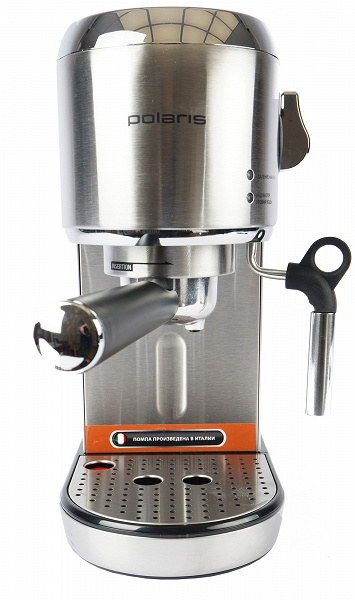
An explanation appeared almost immediately: this Polaris model turned out to be very similar to the compact De’Longhi Dedica carob coffee maker, which was widely used and recognized due to its metal case and miniature dimensions (the device is only 15 cm wide).
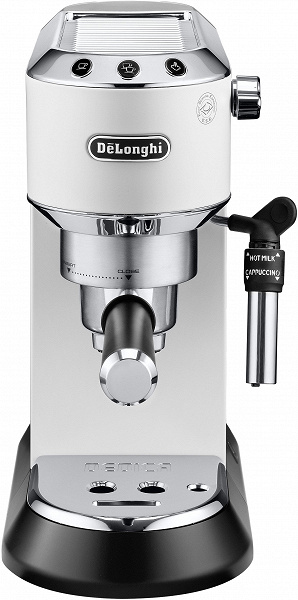
The width of the Polaris PCM 2001AE turned out to be even less – only 14 centimeters. At the same time, the coffee maker also has a metal case and has very similar technical characteristics. And the price of both models is about the same.
Apparently, we can assume that we have a “related” model, which differs only in minor details and design.
Characteristics
| Manufacturer | Polaris |
|---|---|
| Model | PCM 2001AE |
| Type | carob coffee maker |
| Country of Origin | China |
| Warranty | 2 years |
| Service life * | 3 years |
| Declared power | 1400 W |
| Housing material | plastic, metal |
| tank capacity | 1.5 liters |
| Pressure | 20 bar |
| Control | mechanical, electronic |
| The weight | 3.65 kg |
| Dimensions (W×H×D) | 31×30×14 cm |
| Network cable length | 1m |
| Retail offers |
* Contrary to common misconception, this is not the period after which the device will definitely break. However, after this period, the manufacturer ceases to bear any responsibility for its performance and has the right to refuse to repair it, even for a fee.
Equipment
The coffee maker comes in a box designed in “coffee” colors: black and brown background, full-color photos of coffee beans and the coffee maker itself. After studying the packaging, you can get acquainted with the main characteristics and key advantages of the device. In particular, the manufacturer promises us an innovative device for cleaning the cappuccinatore, a pump with a pressure of 20 bar, as well as a book of “recipe ideas” as a gift.
The box is equipped with a plastic handle, which, however, came off almost immediately.
The contents of the box were packed in pressed cardboard inserts and plastic bags. Everything is packaged neatly and securely.
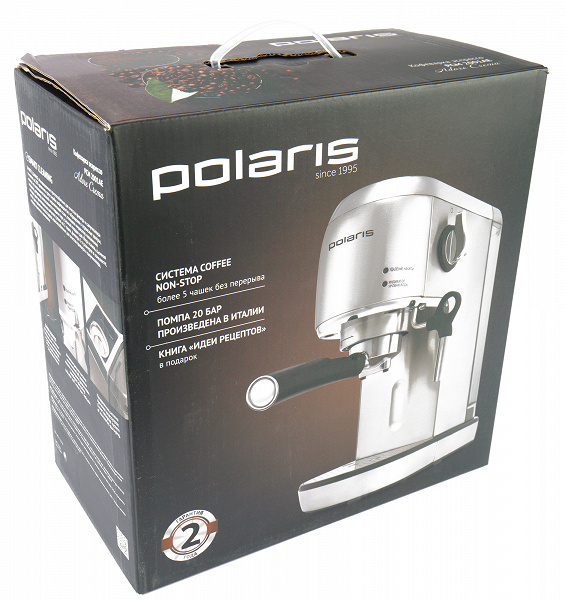
Opening the box, we found inside:
- the coffee maker itself
- horn with two filters
- plastic tamper spoon
- filter cleaner
- templates (stencils) for latte art
- coffee ideas book
- instructions
- warranty card and promotional materials
As we can see, the manufacturer has taken care to make a good impression on the buyer. This is evidenced by an elegant book with full-color printing and high-quality photographs, and a small bonus in the form of three plastic templates for latte art, with which you can create drawings on the surface of the drink.
At first sight
Visually, the coffee maker looks like a device from the “above average” category. There are several reasons for this. First of all, it is, of course, a metal case and an elegant compact design. If there is not enough space in the kitchen, and life is not sweet without espresso, then such a carob coffee maker will be more than appropriate. Let’s take a closer look at the device.
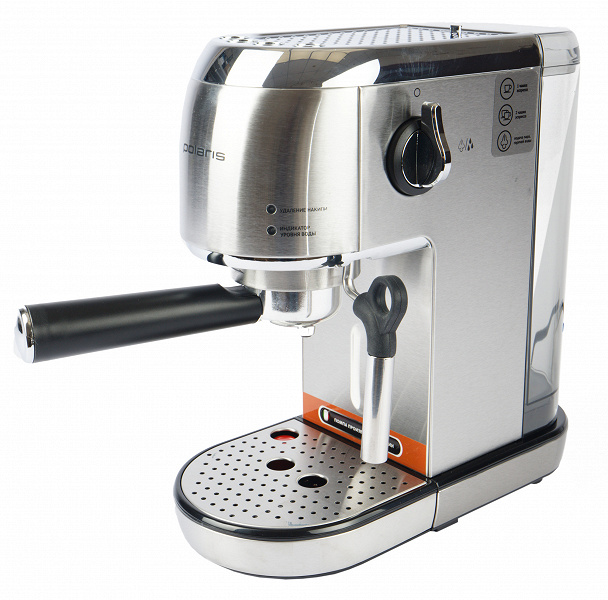
So, as we have already mentioned, one of the main “trump cards” of this model is the case, covered with metal sheets made of matte stainless steel. It looks great, and thanks to this solution, the device looks expensive and solid. The only weak point in terms of design is the upper plastic panel, painted in metallic.
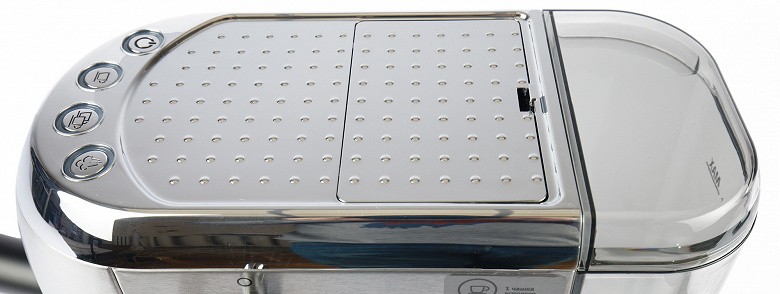
On the back side, we see the power cord outlet and a removable water tank made of darkened plastic, with a plastic removable lid. The volume of the tank is 1.5 liters. The maximum water level (Max) is marked on the back of it. In our opinion, it would be more logical to put such marks on the sides, since in our case we can see the mark only by turning the coffee maker with the back side towards us, or by completely removing the tank.
The water inlet valve is at the bottom. If the tank is removed, the valve will close and water will not pour out of it. The tank is attached to the body of the coffee maker using a small plastic loop.
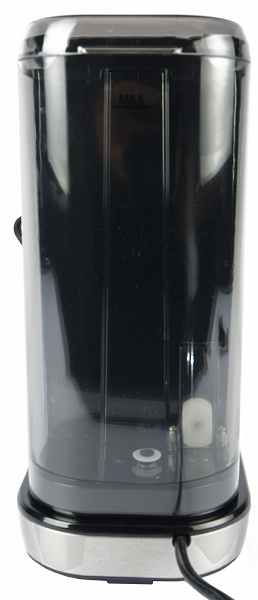
On top, under a plastic cover, there is a compartment for storing a spare filter and cleaning equipment. The lid closes with a latch. Very convenient and neat: additional accessories will not be lost and will not roll around in the kitchen.
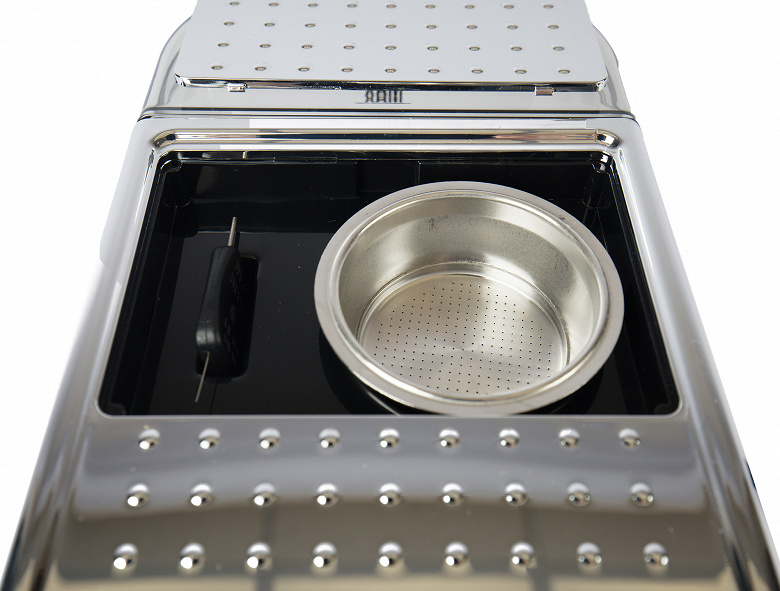
In the same place, on top, we see four control buttons with LED backlight (we’ll talk about them in more detail in the “Control” section). On the right side of the case there are also two LEDs that will remind you that it is time to add water to the tank, or to descale.
From the bottom of our coffee maker there is nothing remarkable. Here we see ventilation holes, a couple of stickers with technical information and a barcode, as well as rubber feet that prevent the device from sliding on the work surface.
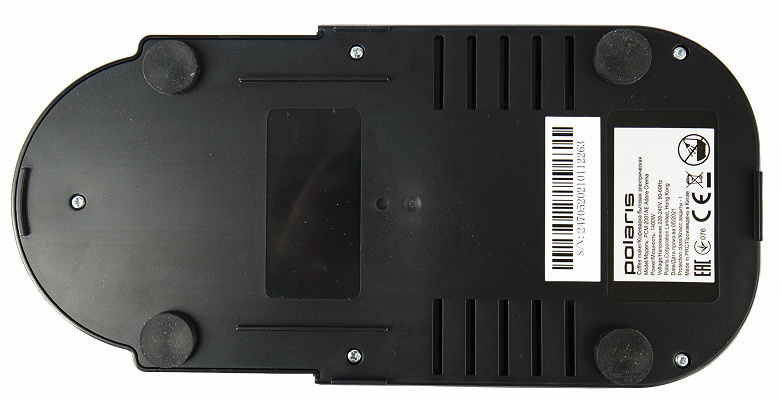
The general view of the coffee maker is classic: in the center there is a group and a horn, below it is a drip tray, on the right is a cappuccino nozzle. The horn is installed with the handle to the left and secured by turning it counterclockwise (the arrow hint reminds you of this). The maximum height of a cup that can fit under the horn is 9.5 cm. Those who wish to prepare two servings of a drink at once will also have to remember that the width of the metal stand is only 13.5 cm. This must be remembered when choosing the right dishes.

The inner part of the group is plastic (it would be better if it was metal!) In the photo below we can see the water supply holes and the rubber gasket.
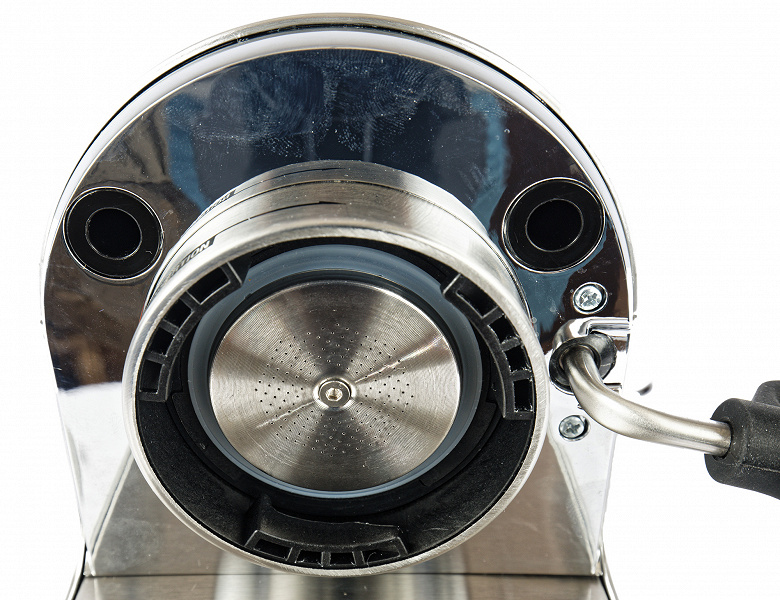
The cappuccinatore has a rubber holder and a removable metal tube. Having removed the external nozzle, you can directly see the cappuccinatore tube with a removable head, which is mounted on a threaded connection. The cappuccinatore can be tilted in any direction, the height of the tube is 8.5 cm from the level of the working surface.
Above the nozzle of the cappuccinatore there is a mechanical knob that smoothly regulates the intensity of steam supply.
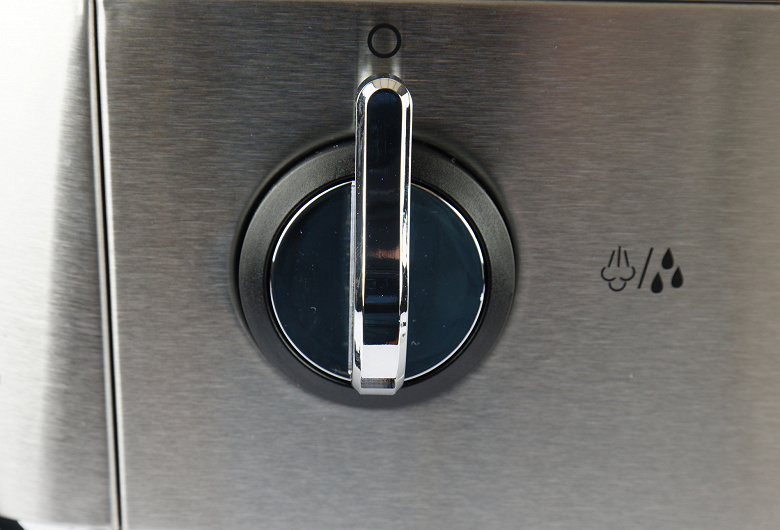
The removable plastic container for collecting drops is closed with a metal lid (recall, it will get scratched pretty quickly and lose its smart look).
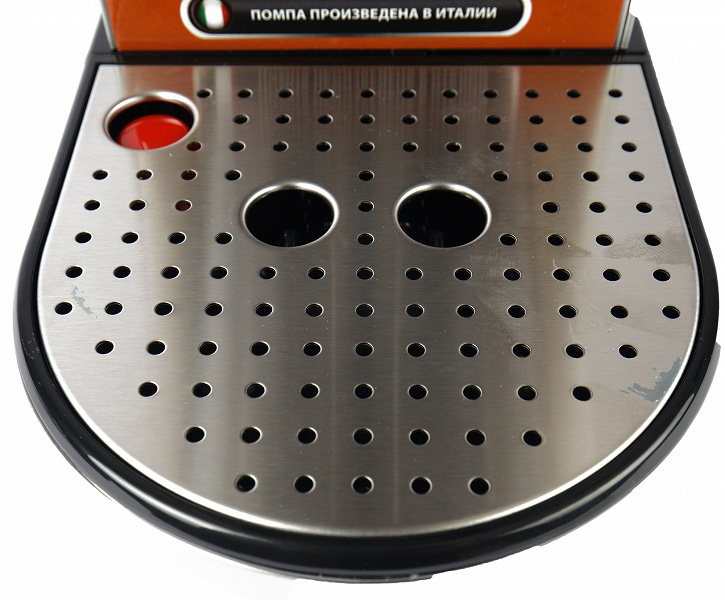
An overflow indicator (red plastic float) is provided on the left side of the container. There is a ledge on the right side of the container, apparently designed to drain liquid directly from the interior of the coffee maker.
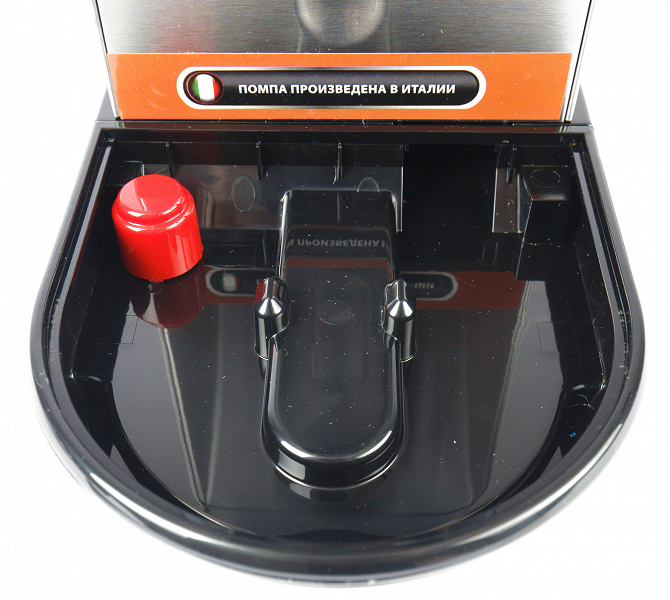
The metal horn with the filter installed weighs 311 grams and has a diameter of 51 mm. At the bottom of the cone, we see a plastic insert that distributes coffee between two spouts.
The set includes two filters (for 1 and 2 servings of espresso, respectively), which are fixed inside the horn with a spring holder. The sides of the filter are provided with finger protrusions that make it easier to remove the filter.
The filters themselves have a double bottom (on the inside we see many small holes, on the bottom – one). Recall that you should not put too finely ground coffee in filters with a double bottom: if it is between the double walls, it will not be easy to extract it.
The “Innovative Cleaner” is just a piece of plastic with two wires. One diameter is suitable for cleaning the filter holes, the second – for the cappuccinatore. These are the innovations we have in 2022!
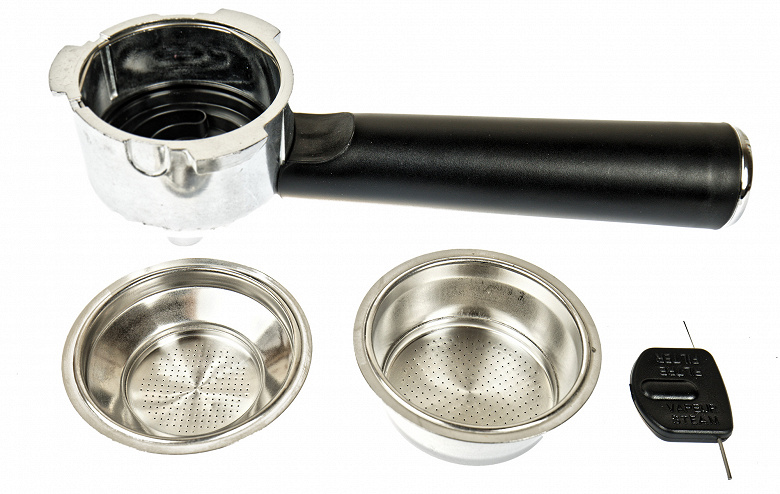
A plastic tamper spoon was also found in the kit. It is generally convenient to use, however, of course, we recommend getting a metal tamper as soon as possible.

We also found three plastic latte art stencils in the box.
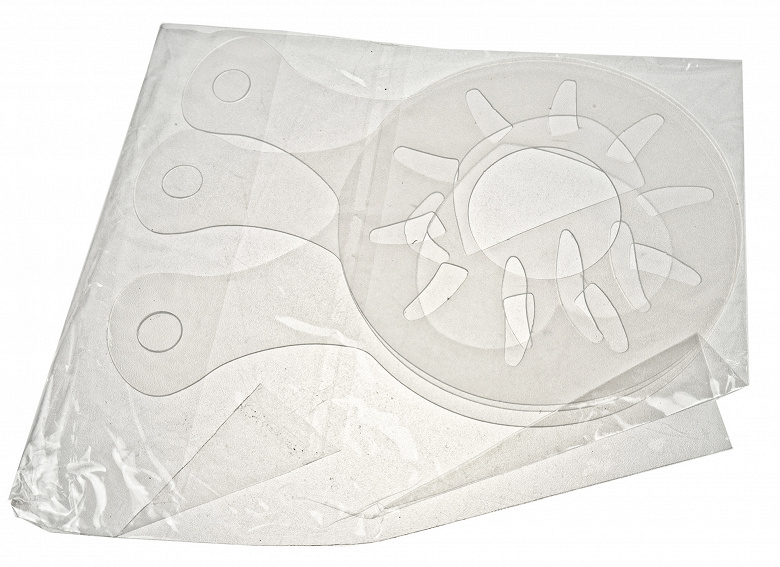
Based on the results of the external examination, we liked the coffee maker. We were especially pleased with the small width of the device (only 14 cm), the metal case and the container for storing accessories.
But the plastic top (on which, in theory, you can put cups to warm them) did not please us too much – in our opinion, it stands out from the overall design of the device.
Instruction
The user manual is a colorful brochure printed on high quality glossy paper using full color printing. The share of the Russian language is 34 pages.
We liked the content of the instructions: here we found comprehensive explanations regarding all aspects of working with the coffee maker. Each item and each action that the user must perform is accompanied by a photograph, so even those who have never encountered carob coffee makers can easily understand the device and the rules for its operation.
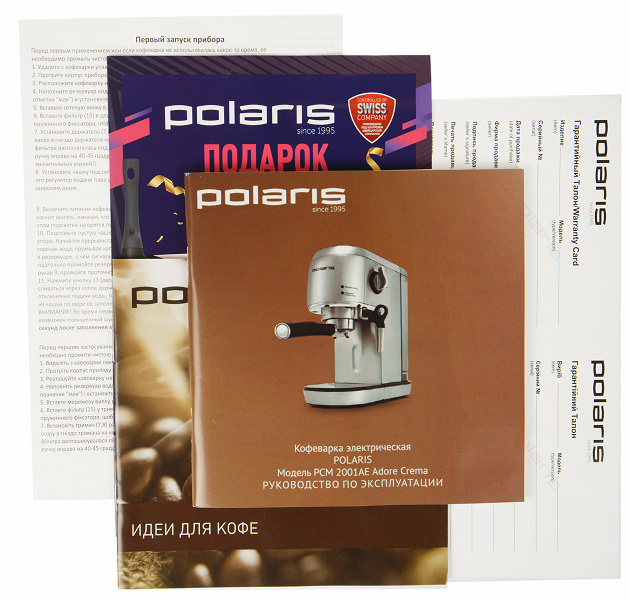
The developers did not forget to tell about the well-known “tricks” that allow you to get the best quality coffee. For example, about the need to warm up the appliance before preparing the first cup of coffee.
Coffee Ideas is a full color booklet containing 13 recipes for various coffee drinks and cocktails. Each recipe is accompanied by a colorful photograph, a detailed description of the preparation and a couple of interesting and informative facts.
Control
The coffee maker is controlled by four buttons and a rotary knob (steam/hot water). Pressing the buttons is accompanied by sound signals (squeak), and the status of the device will be indicated by the LED backlight of the buttons (red or blue).
The purpose of the buttons is generally intuitive, however, some functions of the device are not obvious and require reading the instructions.
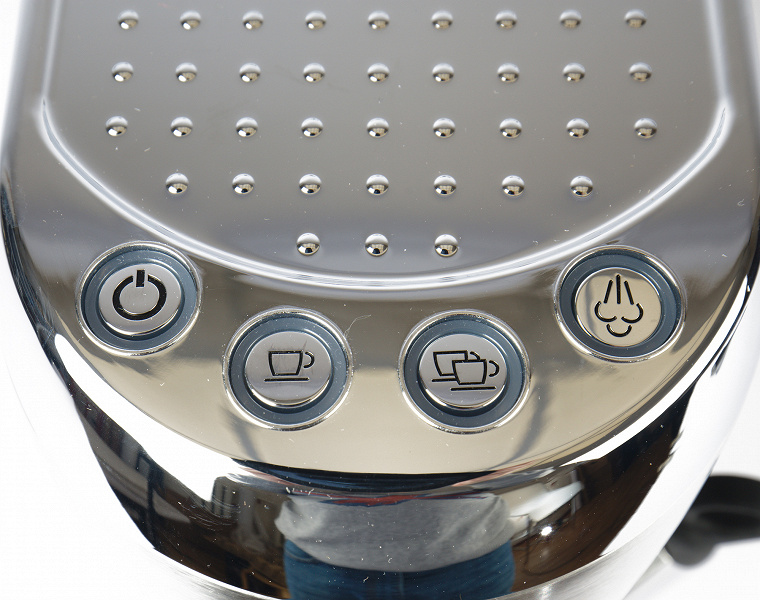
Let’s take a look at the buttons and understand their purpose.
- on off. – turns on the device and starts preheating the water (flashing indicator – heating in progress, constantly lit indicator – heating completed)
- preparation of a single shot of espresso (approx. 40 ml)
- preparing a double shot of espresso (approx. 100 ml)
- button for switching to the “steam” mode (steam heating will be indicated by a flashing on / off indicator)
On the right side of the case there are also two LEDs that will light up if you need to add water to the tank, or to descale.
If desired, the user can change the factory setting for single and double water. To do this, press and hold the corresponding coffee dispensing button until you have the desired amount of coffee. When the button is released, the beverage supply stops, the dose is stored automatically. The next time you press the button, the coffee maker will dispense the previously set amount of drink.
Please note: the programming of the water volume occurs independently for the first and second buttons. That is, the “double portion” button is not “single portion” multiplied by 2, but its own independent program.
Note that this is a very valuable feature that is rarely found in home carob coffee makers. The ability to adjust the brewing time (volume of water) allows you not only to correct the factory settings (which, as a rule, do not allow us to prepare a drink of the desired quality), but also open up possibilities for fine-tuning the quality of the drink depending on the grind or the selected coffee type.
In this case, the user can always cancel the espresso preparation process at any convenient time by simply pressing the selected button again.
To sum up: to make a cup of espresso, we first warm up the machine, then (highly recommended!) pour one shot of water without coffee to warm up, and after that we make a single or double espresso.
To use the cappuccinatore, press the steam button, wait for the coffee maker to warm up, and then start the steam supply using the rotary knob.
If you need hot water, open the cappuccinatore valve without turning on the steam supply mode.
Exploitation
Before the first use, remove the packaging material and advertising stickers, then wash the water tank, cone, filter and drip tray, wipe the coffee maker body with a damp cloth and rinse the device thoroughly by starting the coffee preparation mode (naturally, without coffee itself). It is also recommended to rinse the steamer. Then it is recommended to rinse the tank, filter and holder again. The coffee maker is ready to use.
Let’s note the characteristic features of the device, which we paid attention to during the testing process.
In general, we liked the coffee maker: it turned out to be a simple and understandable device, you can start using it without even reading the instructions – almost everything is clear anyway.
The water container “snaps into place” when installed in the housing. You can add water to the coffee maker without removing the container, but only by opening the lid. The water level can be checked both to the left and to the right of the coffee maker.
The horn of the coffee maker is quite heavy, and warms up well. There are no special devices for extracting a used coffee tablet (such as a locker), so you need to be prepared for the fact that the used coffee will have to be removed using improvised means. At the same time, it is better to place the coffee maker itself not far from the sink – in order to be able to quickly rinse the horn.
The drip tray is easy to remove from the coffee maker, easy to clean and easy to put back.
The maximum height of a cup that can be used with a coffee maker is about 9.5 cm.
As additional advantages, we note the presence of a compartment for storing a second filter and a cleaning device, as well as the fact that the upper plastic panel does not heat up much, but still heats up. You can put at least one cup on it.
And, of course, let’s remember once again that the user can independently adjust the amount of drink that he will receive when pressing the “espresso” and “double espresso” buttons. Judging by the operating experience, the portion size is programmed by the volume of water (and not by the time of the passage), and this is generally correct.
After a while of inactivity, the coffee maker goes into sleep mode, so you don’t have to turn it off every time. On the other hand, those who are used to the fact that the coffee maker is always warm and ready to work are unlikely to be happy with this turn of events. Many who work at home prefer to turn on the coffee maker in the morning and turn it off only in the evening.
We subjectively assess the noise level as low.
Finally, we mention the key feature of this model: our coffee maker does not use a boiler, but a thermoblock, thanks to which the device warms up quickly, allows you to make several servings of coffee in a row and produces more steam than appliances with a boiler.
At the same time, of course, let’s not forget the thermoblock – this is intermittency in the supply of water, slightly less temperature stability and the need for descaling.
What didn’t we like?
The small weight of the coffee maker makes it necessary to hold the device at the moment of removing and installing the horn – otherwise the coffee maker is shifted towards the application of force. Of course, you quickly get used to it, but after working with heavy devices, this feature immediately attracts attention.
Another point is that when you try to get hot water, the cappuccinatore starts actively “spitting”, so if you don’t want to splash the work surface, then it’s better to pick up a mug with high sides to collect water.
Care
Care of the coffee maker means rinsing the horn after each coffee preparation. After washing and in the interval between uses, it is recommended to store the horn separately (so it dries faster).
Periodically, you need to remove and rinse the filter and the space under it. The cappuccinatore must be rinsed after each preparation of frothed milk, otherwise the milk residues will dry out and it will be much more difficult to clean them.
The drip tray must be emptied in a timely manner. The housing may be wiped with a soft cloth.
If scale has formed in the coffee maker, it should be washed with a special agent. To do this, you can use a 3% solution of citric acid, which must be poured instead of water, and then start the coffee maker several times in the coffee and milk foam preparation modes. After such cleaning, in order to wash off the remaining citric acid, you will have to rinse the device again using plain water.
As usual, for the smooth operation of the device, it is recommended to use filtered or bottled water, to clean the device after each use, and to descale it at least once every 2-3 months.
Our measurements
Before starting testing, we measured the energy consumption and the time it took the coffee maker to get ready for work. The power of the coffee maker in the heating mode was up to 1380 W, which almost exactly corresponds to the declared characteristics. In standby mode, the device consumes up to 0.2 W.
Thanks to the use of a thermoblock, and not a boiler, it takes literally 30 seconds to warm up the coffee maker. The first portion of coffee, therefore, can be obtained in 1.5-2 minutes (30 seconds for warming up, another 30 for idle, 30-60 seconds for preparation).
To switch to steam supply mode, you will have to wait another 11-13 seconds.
If you put a mug under the preheated coffee maker and turn on the hot water supply, then its temperature will be 86-88 ° C. This is a very good result (recall that we want to see approximately 93 °C at the moment the coffee comes into contact with water).
We estimate the noise level during operation of the device as low: no more than 55 dBA.
In the case of this device, we consider the power consumption factor to be insignificant.
practice tests
During testing, we prepared a single and a double portion of espresso, whipped milk, and also measured the parameters available to us – spill time, temperature, volume of the finished drink. And, of course, we appreciated the taste of the finished coffee.
For the tests, we took freshly roasted coffee beans that were ground on a burr grinder, pre-set to make espresso in a semi-professional carob coffee maker.
During testing, we found out that our coffee maker prepares coffee with pre-wetting – it feeds a small amount of water into the cone, pauses, and only after that it starts preparing the drink.
Espresso (filter per shot)
Before preparing a single shot of espresso, let’s refresh our memory of the standards for making coffee.
According to the Espresso National Institute recommendations, we need 7±0.5 g of coffee to prepare one serving. The temperature of the water leaving the coffee machine must be 88±2°C and in the cup 67±3°C. The volume of the finished drink, according to the standards, should be 25 ± 2.5 ml. Drink preparation time – 25±5 seconds.
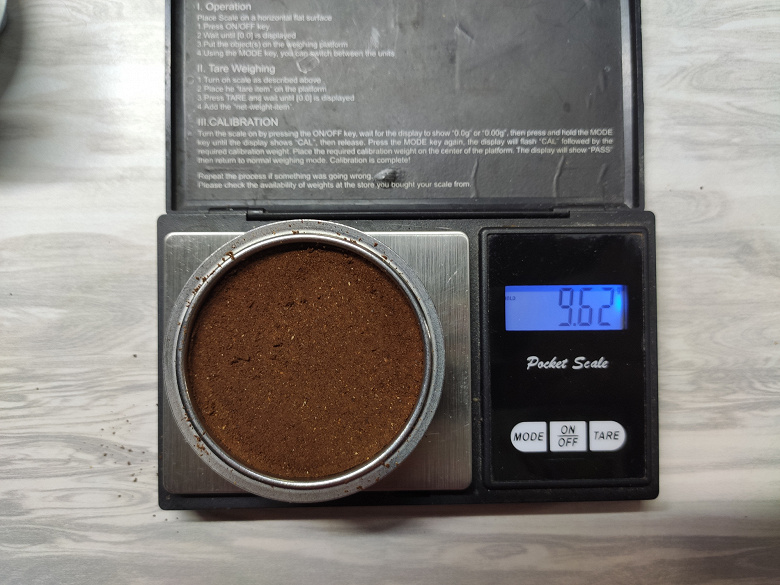
As we can see, a single filter can easily hold 9 grams of coffee and even more, so lovers of making a stronger drink will definitely be satisfied.
What did we get on the standard (factory) settings? In 23 seconds of operation of the coffee maker, we received 43 grams of a drink with a temperature of 75 ° C in a heated cup.
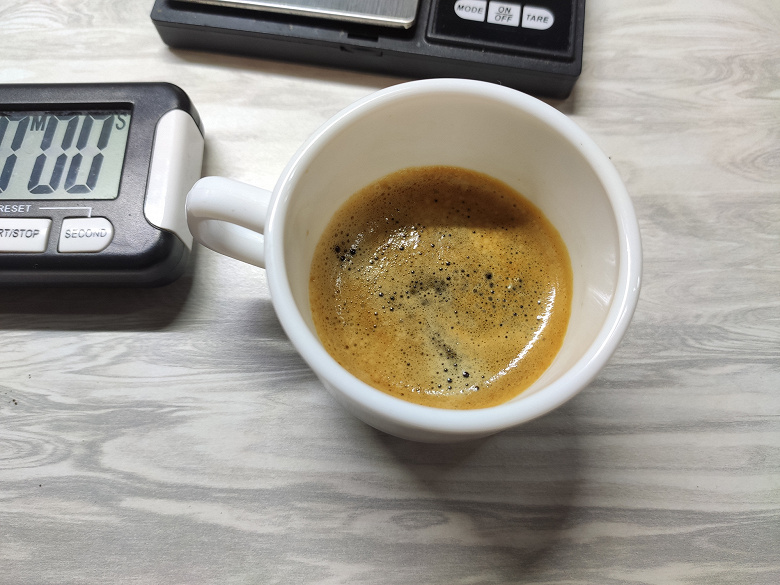
This drink is more suitable for the name “lungo” than “espresso”. There is too much water for real espresso, but in our case this is not a problem: we can make a finer grind, tamp the coffee harder, or slightly reduce the pour time.
At the same time, we liked the taste of the drink, but the foam could have been prettier.
In our opinion, if you are going to make a real espresso in this coffee maker, you cannot do without a high-quality burr coffee grinder, since it is unlikely that you will be able to “guess” the desired grinding when buying already ground coffee in a store.
The spent coffee grounds turned out to be more than dry.
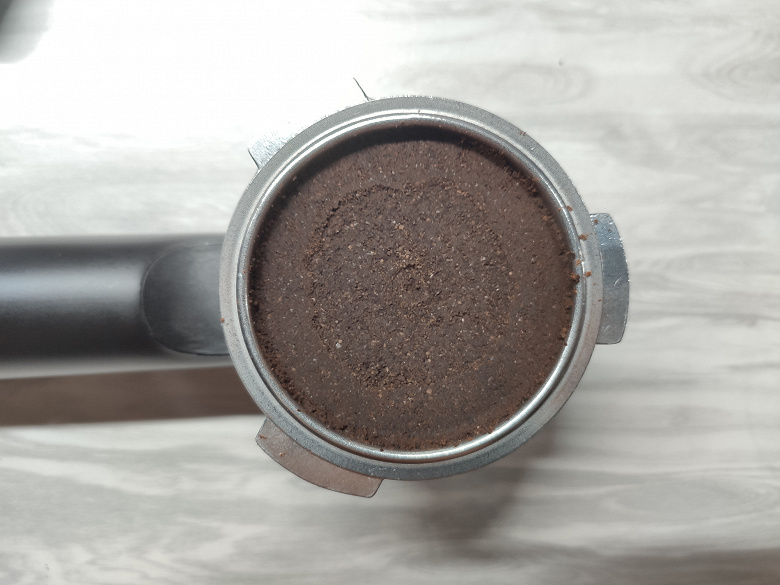
I must say, this is unusual for devices from the budget price category: we expected to see a raw tablet with coffee residue, and were pleasantly surprised by the result.
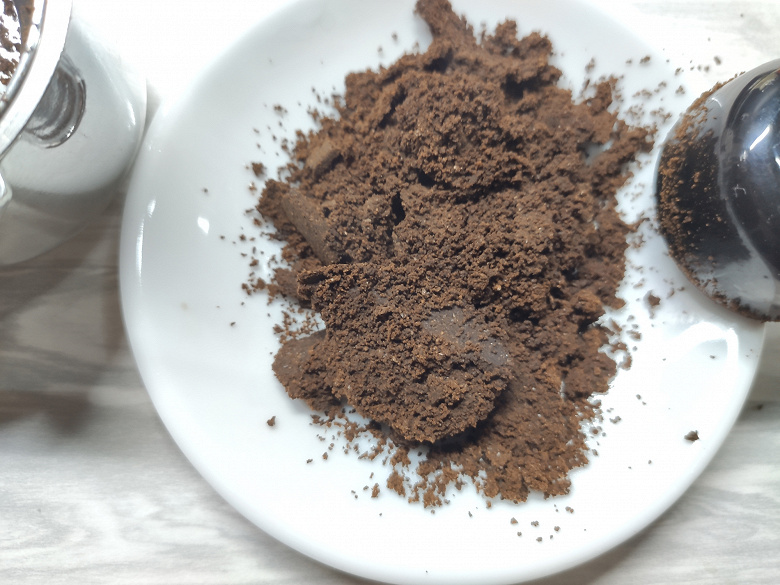
Result: good.
Espresso (filter for two shots)
To make a double espresso, we took a double shot of coffee (the cone can easily hold up to 18 g and there is still room), which was just enough to fill the filter almost to the brim.
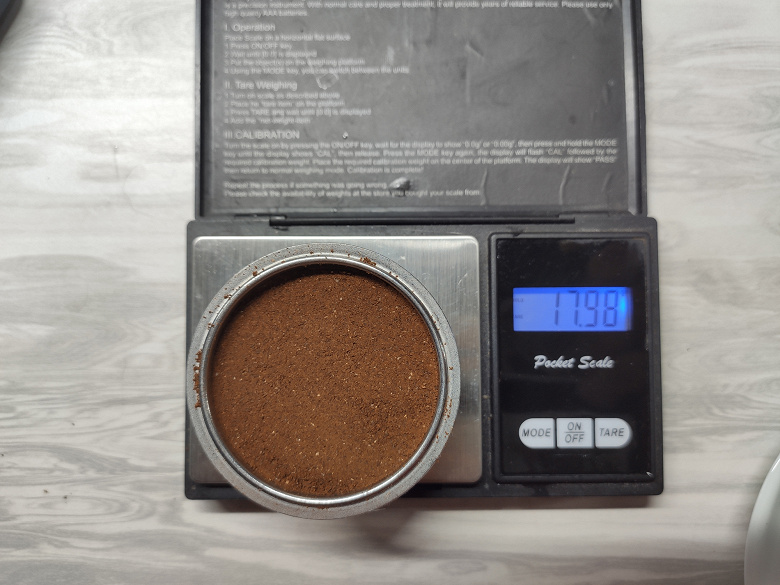
The grinding was taken the same, and our first task is to check what the coffee maker will do in automatic mode.
This time the strait took 1 minute and 20 seconds. During this time, the coffee maker gave out 77 grams of the drink.

We liked the foam of the cream, but the factory settings were not very good. We would be happy to see up to 40 grams of drink in 25-30 seconds. Before us again is not espresso, but rather lungo.
We repeated the experiment, slightly reducing the grind. The results are predictably better.
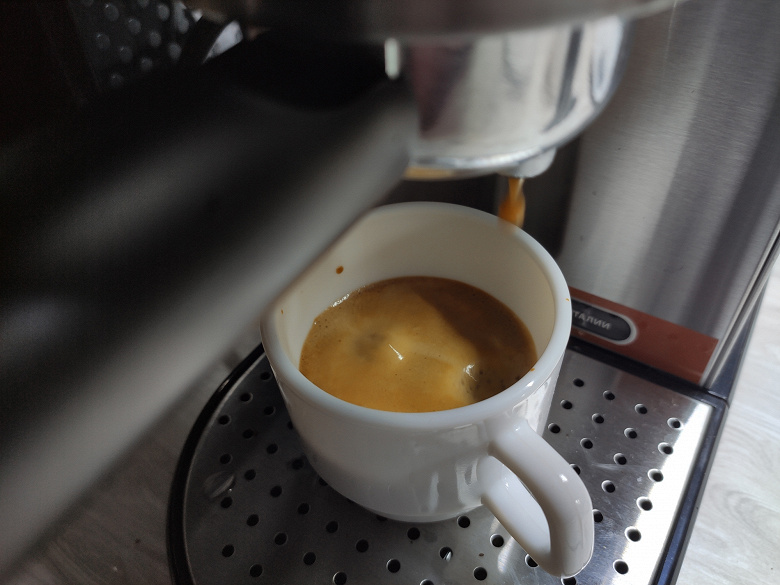
Of course, here we still see more than the desired 35-40 grams of coffee, but in terms of strength and taste, this is already very close to a real double espresso.
As usual, we would recommend that espresso lovers completely abandon the single filter and use only the double one: with it, the result will be more stable and similar to the very espresso that we want to get. Yes, and cooking in a double horn, in general, is easier. Less errors.
If you want to get a not so strong lungo (more water and more strait time), then you can take a filter for one serving.
Result: good.
milk foam
Finally, we tried to make milk foam. To do this, we took 200 ml of milk from the refrigerator, turned on the steam supply to the cappuccinatore tube and began to observe the process.
Note that the cappuccinator tube of our coffee maker is metal. It hides under a large removable tube, which (next to the silicone grip) has a groove for air intake.
It took only 12 seconds to warm up the coffee maker from the “coffee” mode to the “steam” mode, and we opened the steam valve. After that, it was immediately discovered that the intermittent water supply system (and steam too) creates a large amount of splash.
It would be correct to first lower the nozzle of the cappuccinatore into milk, and only then turn on the steam supply (and not vice versa!).
In less than one minute, the milk warmed up noticeably (remember, here we are trying to “catch” about 70 ° C), and the volume of foam turned out to be very large.
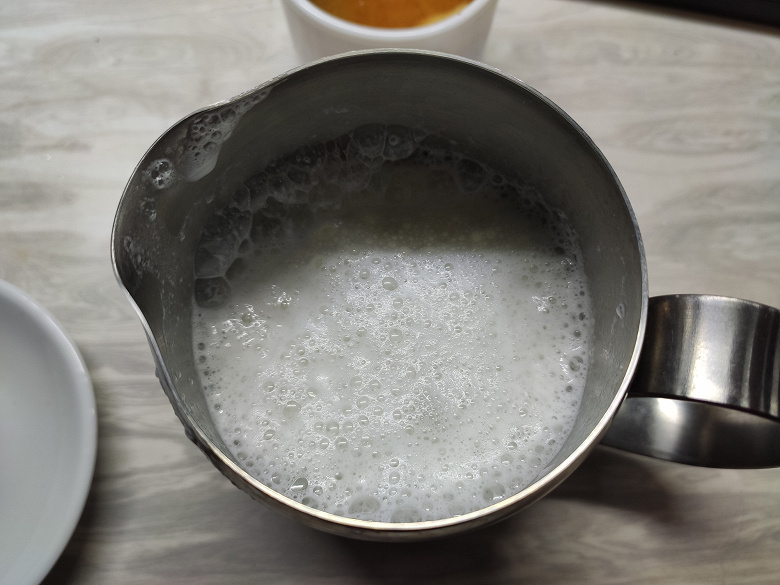
Many large bubbles appeared on the surface of the milk, the steam supply had to be reduced.
After some time, we chose the most suitable angle of inclination and intensity of steam supply and got milk for cappuccino.

Of course, the result was not perfect (you need to get used to the features of the cappuccinatore), but in general we liked using the cappuccinatore. It gives a lot of steam, milk heats up quickly, and foams just as quickly.
Result: good.
findings
Semi-automatic coffee maker Polaris PCM 2001AE occupies a rather specific niche. On the one hand, we have a carob coffee maker for making espresso and drinks based on it. And therefore, we will have to independently select the grind, form a coffee tablet and monitor the volume of water spilled through the coffee. On the other hand, we are offered a little automation in the form of two programs for making single and double espresso: you can program the amount of water dispensed. Well, a filter with a double bottom will not allow a novice coffee lover to brew something frankly inedible.

And of course, a thermoblock instead of a boiler is a serious argument in favor of the fact that this model should be considered from the point of view of an “amateur” and not a “professional” coffee maker. And from the amateur side, I must say, everything is in order. The coffee maker fully corresponds to its price, and we did not reveal any significant shortcomings in it at all. Moreover, for those who prefer lungo rather than espresso, the thermoblock will even be a plus: it, unlike a boiler, can produce a large amount of hot water at a time. In practice, this means that you can easily prepare several double espressos or two lungos in a row, without waiting for the water to reheat and almost without encountering temperature drops.
Finally, the Polaris PCM 2001AE allows you to quickly and conveniently froth milk. Recall that budget coffee makers with a small-volume boiler first warm up for a long time, and then quickly release all the steam and switch back to heating mode, which delays the cappuccino preparation process.
What is missing here, perhaps, is the adjustment of the water supply temperature (which, by the way, De’Longhi Dedica has), but let’s not be too demanding.
Pros :
- adequate price
- two programmable modes – single and double espresso
- can dispense a lot of water/steam at a time
- prewetting mode
Cons :
- factory settings are more likely not espresso, but lungo





